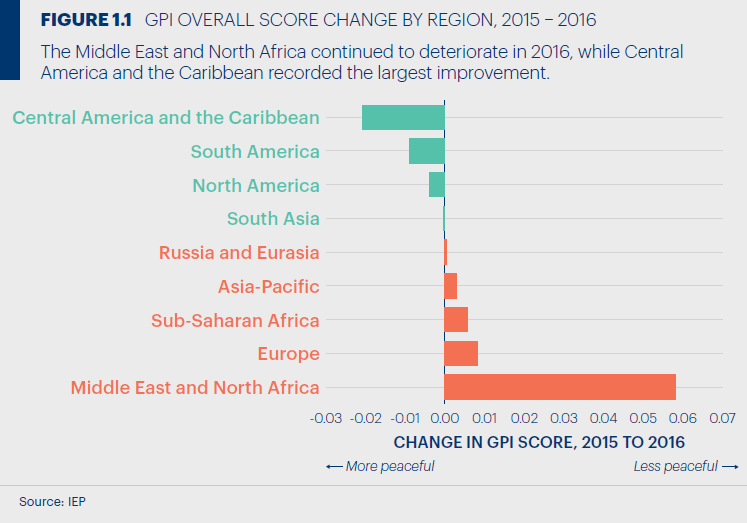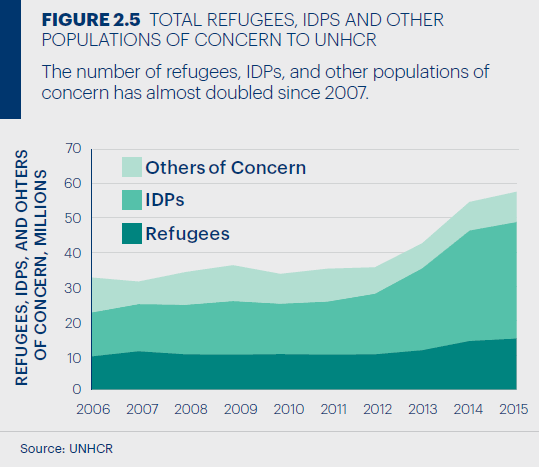
19th June 2016 The world has become less peaceful in 2016 The world has become less peaceful this year – reinforcing an underlying, decade-long deterioration in world peacefulness, driven primarily by increased terrorism and higher levels of political instability.
The tenth edition of the Global Peace Index, published this month, highlights a stark and growing inequality in global levels of peacefulness as the gap between the most and least peaceful countries continues to widen. The study, by international think-tank the Institute for Economics and Peace (IEP), finds that, while 81 countries improved, the deterioration in another 79 outweighed these gains, meaning that overall peace declined at a faster rate than in the previous year. Despite this, some of the most peaceful countries are now recording historically high levels of peace. The score for the Middle East and Africa (MENA) – the least peaceful region in the world last year – dropped further, as regional conflicts intensified, dragging down global peacefulness. So intense is the current concentration of violence and conflict in MENA that, when considered separately, the rest of the world's average peace levels improved. Three of the five biggest declines in peace occurred in the region including Yemen, Libya and Bahrain.
Steve Killelea, Founder and Executive Chairman of the IEP, commented: "As internal conflicts in MENA become more entrenched, external parties are increasingly becoming more involved and the potential for indirect or 'war by proxy' between nation states is rising. This was already evident in Syria with the conflict between the Assad regime and multiple non-state actors, and is now spilling into countries such as Yemen. There is a broader proxy conflict between Saudi Arabia and Iran, and more recently both US and Russia have increased their level of involvement." The global deterioration of peace in 2015 was driven by increased terrorism and higher levels of political instability. While the majority of terrorist activity is highly concentrated in five countries – Syria, Iraq, Nigeria, Afghanistan and Pakistan – the breadth of terrorism is spreading, with just 23% of countries in the Index not experiencing a terrorist incident. Europe, although still the most peaceful region, saw its average score deteriorate in this year's report, following terrorist attacks in Paris and Brussels. Deaths from terrorism in Europe have more than doubled over the last five years. The number of refugees and displaced persons has risen dramatically over the last decade, doubling to approximately 60 million people between 2007 and 2016, nearly 1% of the world's population. There are now nine countries with over 10% of their population displaced in some form; 20% of Somalia and South Sudan's population respectively, and over 60% of Syria's.
While the global economic impact of violence dropped by 2% compared to last year's report, it was still a staggering $13.6 trillion in 2015 – equivalent to 11 times the size of global foreign direct investment (FDI), or about 700 times the annual budget of NASA. This represents 13.3% of world GDP, or $1,876 per person. Over the last ten years, the cumulative total impact of violence was $137 trillion; greater than global GDP in 2015. Steve Killelea remarked, "The increasing internationalisation of internal conflicts has coincided with UN peacekeeping funds reaching record highs in 2016 – it was the largest improved indicator in this year's report, with more deployed peacekeepers and more countries being up-to-date with their UN peacekeeping dues. However, peacebuilding and peacekeeping spending remains proportionately small compared to the economic impact of violence, representing just 2% of global losses from armed conflict. Addressing the global disparity in peace and achieving an overall 10% decrease in the economic impact of violence would produce a peace dividend of $1.36 trillion. This is approximately equivalent to the size of world food exports." Of particular concern is Yemen. Its long-standing political crisis exploded into outright civil war in early 2015. This country has witnessed a major decline in the level of peace, as shown in the diagram below – driven by the rising casualty rate, a large increase in the number of refugees and internally displaced people, and higher levels of terrorist attacks by both al-Qaeda and ISIL. Adding to Yemen's troubles is an emerging water crisis that is likely to worsen from 2017-2025.
The report also provides an audit of available data to measure Goal 16 of the Sustainable Development Goals for 2030 (successor to the Millennium Development Goals of 2015). This new goal – formally agreed last year by UN member states – recognises the critical importance of peace, justice and strong institutions for advancing global development. It finds that, while there is some existing data to track progress and hold member states accountable to meeting their targets, serious investment will be needed to measure the goals. The report concludes with new research into resilience and what the IEP identifies as "Positive Peace" – the attitudes, institutions and structures which can best achieve and sustain global peace. Among those listed are: a well-functioning government with low levels of corruption, good relations with neighbouring countries, the free flow of information, an equitable distribution of resources, investment in education, gender equality and worker's rights. ---
Comments »
|










